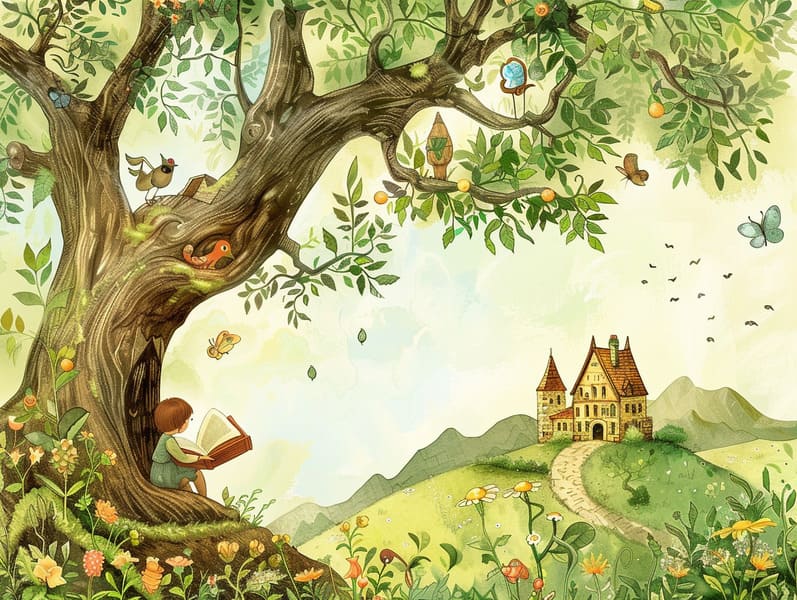
Popular fairy tales have long histories. These narratives have been relayed from one generation to the next far before they were ever transcribed. They arose from a variety of societies, including Indigenous traditions. They were initially passed along among older generations, often carrying themes and messages related to the societal norms and beliefs of the time.
Jacob and Wilhelm Grimm, the two Grimm brothers, were among the first to compile and publish many of these beloved stories. Their collection, "Grimm's Story Collection," included tales like "Cinder Maid," "The Story of Hansel and Gretel," and "Snow-White and Rose-Red," which have since become essentials in the world of famous fairy tales. Similarly, Hans Christian Andersen's magical fairy tales, such as "The Little Mermaid," and "The Duckling's Story," have touched hearts worldwide, solidifying their place in the pantheon of treasured fairy tales.
Despite being ancient, classic fairy tales remain as important as ever, especially as children's bedtime stories. These enchanting tales are now available in diverse formats, including richly illustrated books, whimsical animations, and digital storybooks.
Their unwavering allure can be traced to several delightful features:
Significant Morals: Ancient fairy tales often whisper important moral lessons. Narratives like "The Boy Who Cried Wolf" teach the significance of truthfulness, while "The Story of the Tortoise and the Hare" demonstrate the qualities of tenacity and modesty. These tales offer young readers clear distinctions between virtue and vice, developing their moral compass in a mild yet deep way.
Kindness and Comprehension: Fairy tales frequently feature heroines facing tests and troubles, provoking young readers to understand with their struggles and back their triumphs. For instance, "Beauty's Beast" illustrates the benefit of seeing beyond the surface to acknowledge the real character of a individual, developing warmth and perception.
Cultural Insights: Many old fairy tales are rich in the cultural contexts from which they developed. Delving into these tales can provide illuminating insights into different beliefs, developing a sense of world appreciation and discernment.
Inventiveness and Fantasy: The whimsical elements in old fairy tales—magic wands—kindle children’s dreaming abilities. These tales bring readers to magical realms, promoting fantasy dreams and a sense of mystery that remains a lifetime.
Old fairy tales are not only spellbinding but also instructive. They work as whimsical tools in promoting various cognitive and affective skills in young ones. When fairy tales are narrated, they boost language acquisition by showing new linguistic elements and detailed sentence structures. This practice also enhances auditory skills and attention, as kids concentrate deeply, looking forward to see what happens next.
Furthermore, debating the themes and characters of timeless fairy tales can promote reasoning skills and thought processes. Kids learn to discern patterns, expect results, and catch on to cause and effect. These talks also contribute to children say their thoughts and feelings, fostering their emotional intelligence.
In today’s information age, the accessibility of internet fairy tales has made these this site fairy tales more attainable than ever. Websites and web apps extend large libraries of traditional fairy tales that can be enjoyed or heard anytime, anywhere. Fairy tales spoken are particularly popular, featuring an entertaining method for children to take part in these mesmerizing stories. Audio stories and read-to-me videos bring characters and settings to life, often paired with fantastical background sounds and melodies that enrich the story adventure.
The unending appeal of traditional fairy tales lies in their ability to evolve to the present while keeping hold of their main lessons. Contemporary takes of these stories often introduce more inclusive characters and modern settings, making them meaningful to today’s audience. However, the central morals of bravery, goodness, and integrity remain unchanged, continuing to reach young readers of all ages.
Classic fairy tales also offer a sense of familiarity and recognition. They distribute a ordered narrative with a unmistakable beginning, middle, and end, often wrapping up with the ending of conflicts and the triumph of honesty over deceit. This uniformity can be placating for young readers, sharing a sense of dependability in an constantly changing world.
Ancient fairy tales continue to enchant and train new generations, maintaining their enchantment and importance in modern society. As children's night stories, they bestow a perfect blend of magic and knowledge, furthering moral values, empathy, and creativity. The accessibility of web-based fairy tales and the prevalence of fairy tales narrated assure that these ancient fairy tales remain obtainable to new generations.
By sustaining and making known these tales, we continue to pay tribute to the rich tapestry of mythology and cultural heritage. Whether you are enjoying a beautifully illustrated book, viewing a cyber collection, or listening on an read-aloud story, the delight of famous fairy tales is always within reach. These fairy tales demonstrate of the consistent effect of tales and its ability to bond us across time and space.
Regardless if you are reading a beautifully illustrated book, delving into a web collection, or hearing an sound book, the loveliness of children's fairy tales is always within reach.
These stories teach us of the invariable nature of fairy tales and its ability to connect us across generations and cultures, casting a charm that delights and instructs alike.